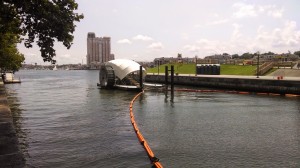
Ocean plastic is bad news. Last week we were learned that not only did every ocean have its own, personal garbage gyre, but that a huge amount of plastic is “missing” from the ocean–that is, it has been incorporated into the ecosystem in ways we don’t yet understand. While there is plenty of misinformation floating around out there about what exactly these garbage patches are (hint: they aren’t solid islands of trash), there is no doubt that they are effecting the global ocean ecosystem in both profound and subtle ways.
Friend of Southern Fried Science and Deep Sea News writer Miriam Goldstein spent her PhD working on the North Pacific Gyre. Her research has revealed invasive pathogenic ciliates living on plastic trash and plastic-eating barnacles floating in the gyre. She also points out one of the biggest problems with trying to clean up these massive, dispersed “garbage patches”:
httpv://www.youtube.com/watch?v=tFSv2eW7g6E
You would almost have to clear-cut the top of the ocean in order to clean up all those little bits of plastic.
There is a sea of theoretical solutions, from dragging nets across the ocean to mooring massive floating arrays, in various states of completeness. Some have been no more than public relation stunts, while others push on despite extensive criticism from oceanographers and other marine experts. Some have promise, other appear to be no more than press releases.
Amid the TED talks, press-pushes, empty promises, and gratuitous publicity stunts, the City of Baltimore quietly built, tested, re-designed, re-built, and deployed a solar-powered, trash-eating, waterwheel-driven garbage scow that’s plying the urban waters of the Chesapeake Bay, pulling tons of trash out of the Inner Harbor every day. Say hello to the Inner Harbor Water Wheel.